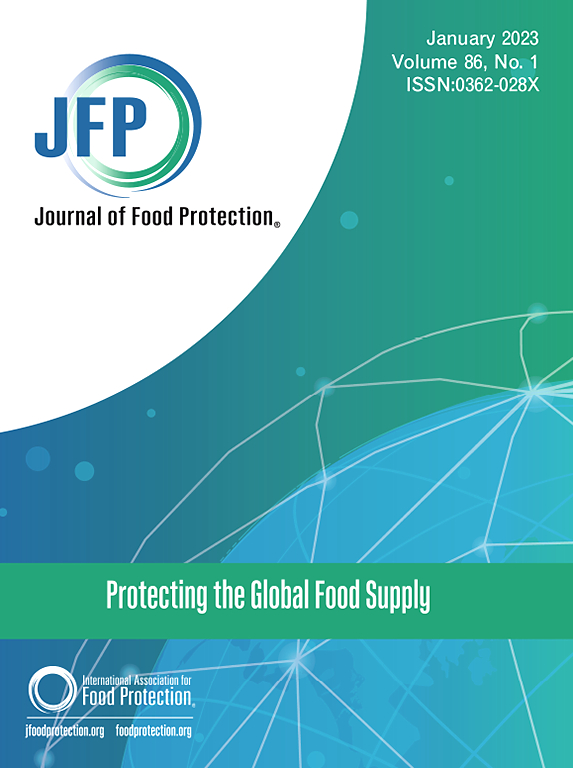An Overview of Multistate Outbreak Investigations of Salmonella Infections Linked to Fish and Fishery Products, United States – 2012–2021
IF 2.8
4区 农林科学
Q3 BIOTECHNOLOGY & APPLIED MICROBIOLOGY
引用次数: 0
Abstract
Salmonella infections linked to seafood consumption have the potential to cause serious illness, with reported incidence of foodborne illness associated with contaminated seafood increasing in the past decade. While technological advancements over the last decade have made significant progress in the detection, reporting, and determining the source of illness from bacterial pathogens including Salmonella, prevention of these illnesses remains the same, basic sanitation control. We examined data from Salmonella outbreaks linked to fish and fishery products (excluding raw molluscan shellfish) during the period 2012–2021. In that time, there were five confirmed multistate Salmonella outbreaks, including 633 illnesses and 92 hospitalizations associated with fish and fishery products, and four additional multistate outbreaks with 88 illnesses and 12 hospitalizations where fish and fishery products were a suspect vehicle. We summarize common findings and challenges in the traceback investigations related to these outbreaks, particularly considering traceback challenges involving imported seafood, and discuss sanitary practices and regulatory approaches to prevent Salmonella outbreaks linked to fish and fishery products. Some of the most frequent insanitary observations included the safety of the water used in manufacturing food and ice; using water hoses to create overspray that may cross-contaminate food and food contact surfaces in the processing areas; and inadequate cleaning and sanitizing. Environmental contamination (e.g. from bird feces and insects) and improperly sanitized surfaces and cutting tools were also observed in some inspections. Sanitation controls are especially critical for raw ready-to-eat seafood and controls ensuring proper cooking and sanitary conditions and practices after cooking are critical for cooked products. These sanitation controls prevent foodborne outbreaks and recalls, safeguard consumers, and maintain trust in the food supply chain.
2012-2021年美国与鱼和渔业产品有关的沙门氏菌感染的多州暴发调查综述
与海鲜消费有关的沙门氏菌感染有可能导致严重疾病,据报道,在过去十年中,与受污染的海鲜有关的食源性疾病发病率有所增加。虽然过去十年的技术进步在检测、报告和确定包括沙门氏菌在内的细菌性病原体的疾病来源方面取得了重大进展,但这些疾病的预防仍然是基本的卫生控制。我们检查了2012-2021年期间与鱼类和渔业产品(不包括生软体贝类)有关的沙门氏菌爆发的数据。在此期间,有5次确认的多州沙门氏菌爆发,包括与鱼和渔业产品有关的633例疾病和92例住院治疗,另外4次多州爆发,88例疾病和12例住院治疗,其中鱼和渔业产品是可疑的运输工具。我们总结了与这些暴发有关的追溯调查的共同发现和挑战,特别是考虑到涉及进口海鲜的追溯挑战,并讨论了卫生实践和监管方法,以防止与鱼和渔业产品有关的沙门氏菌暴发。一些最常见的不卫生观察包括用于制造食品和冰的水的安全性;使用水管造成过度喷洒,可能会交叉污染加工区域的食品和食品接触面;清洁和消毒不足。在一些检查中还观察到环境污染(例如鸟粪和昆虫)和未适当消毒的表面和切割工具。卫生控制对生的即食海鲜尤其重要,而确保适当烹饪和烹饪后的卫生条件和做法的控制对熟产品至关重要。这些卫生控制措施可防止食源性暴发和召回,保护消费者,并维持对食品供应链的信任。
本文章由计算机程序翻译,如有差异,请以英文原文为准。
求助全文
约1分钟内获得全文
求助全文
来源期刊

Journal of food protection
工程技术-生物工程与应用微生物
CiteScore
4.20
自引率
5.00%
发文量
296
审稿时长
2.5 months
期刊介绍:
The Journal of Food Protection® (JFP) is an international, monthly scientific journal in the English language published by the International Association for Food Protection (IAFP). JFP publishes research and review articles on all aspects of food protection and safety. Major emphases of JFP are placed on studies dealing with:
Tracking, detecting (including traditional, molecular, and real-time), inactivating, and controlling food-related hazards, including microorganisms (including antibiotic resistance), microbial (mycotoxins, seafood toxins) and non-microbial toxins (heavy metals, pesticides, veterinary drug residues, migrants from food packaging, and processing contaminants), allergens and pests (insects, rodents) in human food, pet food and animal feed throughout the food chain;
Microbiological food quality and traditional/novel methods to assay microbiological food quality;
Prevention of food-related hazards and food spoilage through food preservatives and thermal/non-thermal processes, including process validation;
Food fermentations and food-related probiotics;
Safe food handling practices during pre-harvest, harvest, post-harvest, distribution and consumption, including food safety education for retailers, foodservice, and consumers;
Risk assessments for food-related hazards;
Economic impact of food-related hazards, foodborne illness, food loss, food spoilage, and adulterated foods;
Food fraud, food authentication, food defense, and foodborne disease outbreak investigations.
 求助内容:
求助内容: 应助结果提醒方式:
应助结果提醒方式:


